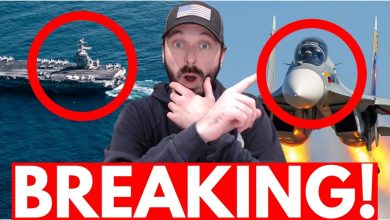Fat Bear Week Is Here! Vote for Your Favorite Burly Bruin

Winter is coming, and the brown bears at Alaska’s Katmai National Park & Preserve (KNPP) are packing on the pounds. They’re working hard, gobbling salmon, preparing for the long sleep, and getting rounder by the day.
“Fat phobia” and “fat shame” do not exist in these bears’ lexicon — rising obesity rates are a sign of a healthy, successful population. In bear country, the saying goes: The fatter, the better.
And boy, are there some fatties out there right now. From Sept. 23 to 30, you can vote for your favorite. Fat Bear Week is back, baby! In partnership with Explore.org, the park’s live nature camera network, Katmai has been keeping close tabs on its bears as they’ve been putting on weight.
“Chunk’s resilience, Grazer’s skill, and Bucky’s intelligence are only a few of the amazing stories we followed at Brooks River this summer,” founder of Explore.org, Charlie Annenberg, said in a press release. “The bears have grown as fat as I’ve ever seen them, thanks to another exceptional salmon run. Go big or go home!”
Last year, over 1.2 million people cast their votes and — for the second year in a row — chose bear 128 (aka “Grazer”) as the KNPP Fat Bear Week champion.
This year, Grazer is back in the running for the third consecutive year, alongside several other past competitors. Bears 909, 503, 32, 128, and others are going head-to-head, haunch-to-haunch, and your vote will determine which is the ultimate fan favorite fat bear.
Check out the bears, cast your vote on the Explore.org website, and on September 30, the park will crown its 2025 Fat Bear Week winner.
Fat Bear Week 2025: Meet the Contestants
Bear 128 (aka “Grazer”)
The returning champion, Grazer, is a big ol’ Mama Bear with a mean appetite. She’s known for her ferocious and protective mothering and is currently raising her third litter of cubs this year.
Coincidentally, she’s also up for her third consecutive Fat Bear Week championship. This clever mama knows the best fishing spots around Katmai and works them like a pro. There’s a reason she’s back in the running again — this bear knows how to get fat. And this year she clearly didn’t hold back.
Bear 32 (aka “Chunk”)
Chunk is one of the bigger (and meaner) bears in Katmai. He has a big scar on his nose from a past fight, and this year he broke his jaw. The injury meant he had to adapt to fishing without full use of his mouth. His sheer size and experience helped him not only survive the year but also thrive. Judging by the size and roundness of this behemoth, he was successful despite the handicap.
Bear 910
Another big mama, Bear 910, knows how to fish Brooks Falls like a true professional. She’s raised at least one litter of cubs so far, but ahead of this winter, she’s focused on herself and making sure she’s got the fat storage to coast through hibernation.
Bear 909
Bear 909 lost a litter of cubs earlier this year. The loss didn’t slow her down, though. She continued hunting, foraging, and scrounging up as much food (read: fat) as she could get her paws on. Clearly, she’s had a successful year, and when she comes out of the long sleep next spring, she’ll be ready to raise another litter of baby brown bears. Visit the Explore.org Fat Bear Week webpage to see full profiles for all of the bears and vote for your favorites.
How Do Rangers Weigh the Bears?
While you might imagine bears lining up at a scale for the annual Fat Bear Week weigh-in, it’s not quite so simple. Park rangers and biologists actually use a GIS laser scanner to “non-invasively measure the volume” of Katmai’s bears. It’s similar to Lidar scanners used in civil engineering to scan roads, buildings, or bridges — only in this case, it’s scanning fat bears.
This is the first time this technology has been applied to measure bears’ heft and girth. It requires that the bears stand still for several seconds while the rangers scan their bodies. To get the best scan, they ideally need a full broadside view of the bear. Legs are often not included in the calculation — just the bears’ big, round torsos, shoulders, neck, and head.
Why Is Fatter Better?
Everyone knows that bears hibernate. From late fall into early spring, they curl up in their dens and sleep away the winter months. They don’t eat or drink at all during this time period and lose about one-third of their body weight. Having fat stored up is essential to not only surviving hibernation but also coming out the other side strong enough to thrive the following season.
But there’s more to it than that. Male bears with more mass can assert themselves better to secure the most fruitful fishing spots and fend off challengers. Female bears need to gain weight so they can sustain themselves while they hunt for and feed their cubs. Adolescent bears have to store fuel to feed their growth spurts.
That means that bears are laser-focused on fattening up all fall. They seek out the highest-fat foods available, and in Katmai, that’s salmon. Some of these bears will eat over 40 sockeye daily, and can gain weight at the incredible rate of over 2 pounds a day.
Fat Bear Week: Time-Honored & Extremely Popular Tradition
KNPP is on a peninsula in the Brooks Range of Alaska. It is home to between 40 and 70 brown bears in a given year, which are supported by healthy populations of sockeye salmon. During the fall salmon run, the rivers are so full of fish you can’t even see the bottom. Katmai’s bears feast to their hearts’ content.
Katmai’s Brooks Camp in particular has become famous for the Explore.org bear cams, which livestream footage of these bears fishing, hanging out, and doing other bear stuff 24/7. You can view them on the Katmai live cam webpage.
Fat Bear Week started in 2014, and at the time, only 1,700 people cast their votes. Since then, the competition has grown to immense proportions, just like the bears it’s centered around. In 2024, 1.2 million people participated in Fat Bear Week, with even more expected in 2025. It has become the park’s biggest annual marketing campaign, raising awareness about bears and resources to help protect their natural habitats.
You can learn more about KNPP on the National Park Service (NPS) website.
Read the full article here








